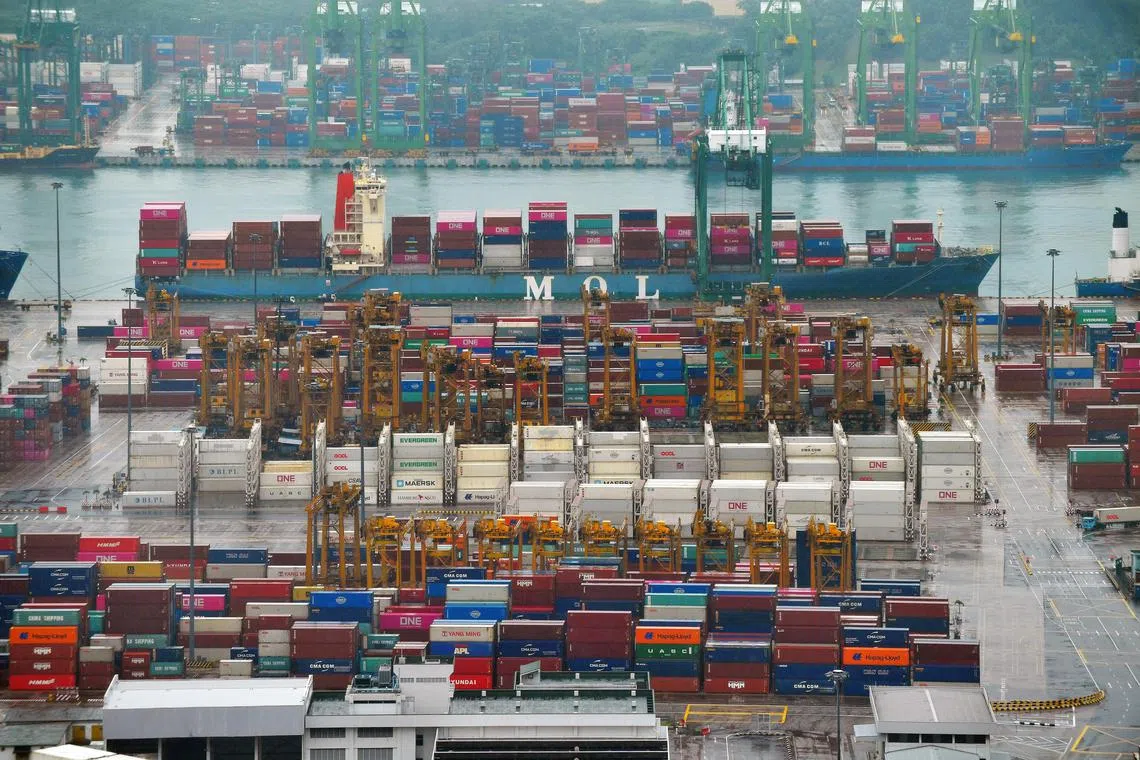Singapore non-oil exports tumble 20.6% in December, worse than expected
Sign up now: Get ST's newsletters delivered to your inbox

Year on year, total trade decreased by 7.7 per cent in December 2022.
ST PHOTO: ALPHONSUS CHERN
Follow topic:
SINGAPORE – Singapore’s key exports slumped for the third straight month in December, according to data from Enterprise Singapore (EnterpriseSG) on Tuesday, on rapidly cooling global demand.
Non-oil domestic exports (Nodx) for December fell 20.6 per cent from a high base a year earlier, the worst contraction in nearly a decade, said Maybank economists Lee Ju Ye and Chua Hak Bin in a report.
The contraction was also worse than Bloomberg’s forecast for a 16.8 per cent drop and the revised drop of 14.7 per cent for November.
In real terms – after adjusting for the effect of price changes – Nodx plunged by 19 per cent, extending the 15.1 per cent fall in November.
For the whole of 2022, EnterpriseSG said, Nodx grew by 3 per cent – just half of the official forecast for around 6 per cent growth.
The Nodx forecast for 2023 is for minus 2 per cent to 0 per cent growth, EnterpriseSG said in its November trade review.
ANZ head of Asia research Khoon Goh said demand for Asia’s exports will remain weak in the first quarter of the year and potentially even in the second quarter.
“There is consensus now that the US economy will go into a recession and therefore we should not expect any quick rebound in demand,” Mr Goh said.
He added that a lot of US retailers have not been able to clear their inventories because of the collapse in new orders recently.
For December, both electronic and non-electronic shipments again saw sharp double-digit contractions.
Electronic Nodx fell for the fifth straight month, slipping 17.9 per cent in December after declining 20.2 per cent in November.
Shipments of personal computer parts fell the most, by 41.7 per cent. Shipments of integrated circuits were down 26 per cent, and disk media products by 36.5 per cent.
Non-electronic Nodx also extended its slump to the lowest level since February 2021, shrinking by 21.3 per cent in December after the 12.8 per cent decrease in the previous month.
DBS Bank senior economist Irvin Seah said Singapore’s manufacturing sector – about 20 per cent to 25 per cent of the economy – is already in a recession.
He noted that global semiconductor shipments and billing figures have plummeted sharply.
The service sector is supporting the economy for now, he added, noting that some segments of this sector, such as logistics and transport, will ultimately feel the negative spillover from the manufacturing slump.

ANZ’s Mr Goh said Singapore’s key electronic sector should be prepared for further weakness over the next two quarters until there are signs that the technology sector, which peaked in 2022, has bottomed out.
In terms of export markets, the slump in shipments to China continued as Nodx tumbled 31.8 per cent after contracting 31.2 per cent in November.
Nodx to some of Singapore’s other top markets declined too, with exports to major economies such as the United States and European Union falling into the red in December.
UOB senior economist Alvin Liew said exports to the US fell for the first time in December after six months of growth.
He said the weakness in regional demand from Asean was especially concerning. Intra-regional trade continued to weaken broadly in December, led by Malaysia, Indonesia and Thailand.
But exports to South Korea reversed the fall in November to rise by 14.3 per cent, while exports to Japan continued rising, by another 6.8 per cent.
Both Mr Seah and Mr Goh said it will take a while before Singapore’s economy experiences any positive spillover from China’s reopening. They expect Singapore’s single largest export market to pick up only from the middle of 2023.
Mr Seah said China will be an important impetus for the manufacturing sector, but noted that the path to reopening will not be smooth as Beijing will have to overcome a few waves of Covid-19 infection and continue to push through with its reopening policy.
He sees some potential upside surprises in manufacturing and overall economic performance in the second half of the year.
On a month-on-month seasonally adjusted basis, Nodx declined by 3.3 per cent in December following November’s 9.2 per cent decrease.
This was also worse than Bloomberg’s forecast for an increase of 1 per cent month on month.
Year on year, total trade decreased by 7.7 per cent in December following the 2.4 per cent decline in the preceding month.
For the whole of 2022, total trade grew by 17.7 per cent to $101.3 billion.


